新编语言学教程名词解释(部分重点)
- 格式:doc
- 大小:27.50 KB
- 文档页数:2
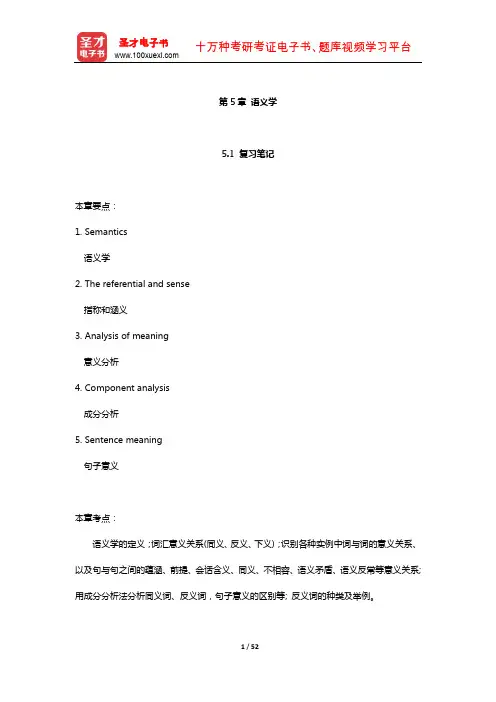
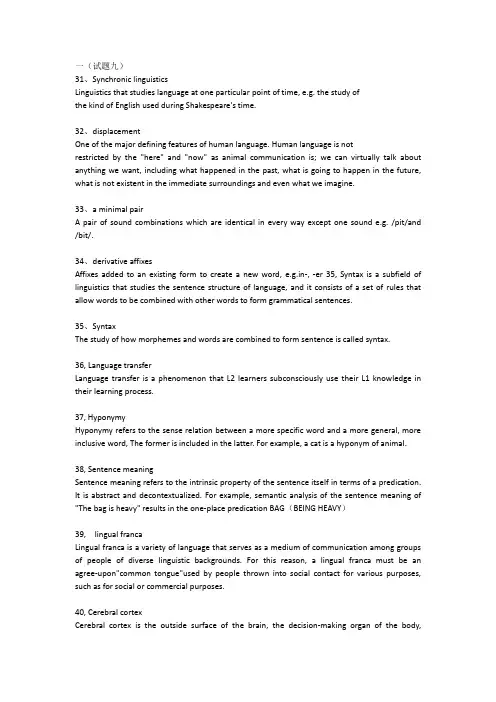
一(试题九)31、Synchronic linguisticsLinguistics that studies language at one particular point of time, e.g. the study ofthe kind of English used during Shakespeare's time.32、displacementOne of the major defining features of human language. Human language is notrestricted by the "here" and "now" as animal communication is; we can virtually talk about anything we want, including what happened in the past, what is going to happen in the future, what is not existent in the immediate surroundings and even what we imagine.33、a minimal pairA pair of sound combinations which are identical in every way except one sound e.g. /pit/and /bit/.34、derivative affixesAffixes added to an existing form to create a new word, e.g.in-, -er 35, Syntax is a subfield of linguistics that studies the sentence structure of language, and it consists of a set of rules that allow words to be combined with other words to form grammatical sentences.35、SyntaxThe study of how morphemes and words are combined to form sentence is called syntax.36, Language transferLanguage transfer is a phenomenon that L2 learners subconsciously use their L1 knowledge in their learning process.37, HyponymyHyponymy refers to the sense relation between a more specific word and a more general, more inclusive word, The former is included in the latter. For example, a cat is a hyponym of animal.38, Sentence meaningSentence meaning refers to the intrinsic property of the sentence itself in terms of a predication. It is abstract and decontextualized. For example, semantic analysis of the sentence meaning of "The bag is heavy" results in the one-place predication BAG(BEING HEAVY)39, lingual francaLingual franca is a variety of language that serves as a medium of communication among groups of people of diverse linguistic backgrounds. For this reason, a lingual franca must be an agree-upon"common tongue"used by people thrown into social contact for various purposes, such as for social or commercial purposes.40, Cerebral cortexCerebral cortex is the outside surface of the brain, the decision-making organ of the body,receiving messages from all sensory organs and initiating all voluntary actions. Many of the cognitive abilities that distinguish humans from other mammals, such as sophisticated reasoning, linguistic skills, and musical ability, are believed to reside in the cortex.二(试题一)31、dualityOne of the major defining features of human language, Human language consists of two levels. At the lower level, there are a limited number of sounds which are meaningless while at the higher level there are an unlimited number of combinations of these sounds. It is also known as double articulation.32 、diachoronic linguisticsLinguistics that studies language over a period Di time, also known as historical linguistics, e.g. the study of the Chinese language since the end of the Qing dynasty up to the present.33, broad transcriptionA way to transcribe speech sounds. The basic principle is to use one letter to indicate one sound. It is generally used in dictionaries and language teaching textbooks.34, morphological rulesThe rules that govern which affix can be added to what type of stem to form a new word, e.g. -ly can be added to a noun to form an adjective.35, phrase structure rulea rewrite rule that allows for the possible combinations of words to form phrases and sentences.36 relational oppositesRelational opposites, a kind of antonyms, refer to pairs of words that exhibit the reversal of a relationship between the two items, For example, "husband" and "wife", "father" and "son" etc.37、componential analysisComponential analysis is a way proposed by the structural semanticists to analyze word meaning. The approach is based upon the belief that the meaning of a word can be dissected into meaning components, called semantic features. For example, the word "man" is analyzed as composing of +HUMAN, +ADULT, +ANIMATE, +MALE.38 ContextContext is regarded as constituted by all kinds of knowledge assumed to be shared by the speaker and the hearer, For example, the knowledge of the knowledge used and the knowledge of the world, including the general knowledge about the world and the specific knowledge about the situation in which linguistic communication is taking place.39,euphemismA euphemism is a mild, indirect or less offensive word or expression that replaces a taboo word or serves to avoid more direct wording that might be harsh, unpleasantly direct, or offensive, e.g." pass" away for "die".40,brain lateralizationBrain lateralization refers to the localization of cognitive and perceptual functions in a particular hemisphere of the brain. For example, the right hemisphere processes stimuli more holistically and the left hemisphere more analytically. In most people, the left hemisphere has primary responsibility for language, while the right hemisphere controls visual and spatial skills.试题七1、ReferenceReference means what a linguistic from refers to in the real, physical world; it deals with the relationship between the linguistic element and the non-linguistic world of experience.2、perlocutionary actA perlocutionary act is the act per-formed by or resulting from saying something ; it is the consequence of, the change brought about by the utterance; it is the act performed by saying something.3、Linguistic tabooA linguistic taboo refers to a word or expression that is prohibited by the "polite" society from general use, such as obscene, profane and swear words etc.试题六1. assimilation ruleA phonological rule that makes one sound similar to a neighboring one by copying one of it phonetic features. For example, the /i: /sound in/: /to some extent nasalized because it is assimilated by the nasal sound /n/that follows it immediately.2.rootA root is often seen as part of a word; it can never stand by itself though it bears clear,definite meaning: it must be combined with another root or an affix to form a word, e.g. liter-in literal, and literature.3. bound morphemesThe morphemes that cannot be used by themselves, but must be combined with other morphemes to form words that can be used independently4. surface structureA level of syntactic representation after the operation of necessary syntactic movement.5. grammaticalityGrammaticality refers to the grammatical well-formedness of a sentence. It is governed by the grammatical rules of the language. A grammatically well-formed sentence may not be semantically meaningful, For example, Green clouds are sleeping furiously6. elaborationElaboration is a kind of language change. it occurs when there is a need to reduce ambiguity and increase communicative clarity or expressiveness.7. bilingualismBilingualism refers to a linguistic situation in which two standard languages are used either by an individual or by a group of speakers, such as the inhabitants of a particular region or a nation.8. creoleCreole refers to a language that is originally a pidgin, which comes to be adopted by a community as its native tongue, and children lean it as their first language9. the Sapir-whorf hypothesisThe hypothesis refers to the theory put forward by the American anthropological linguists Sapir and Whorf, which states that the language we speak determines the way we perceive the world and therefore the nature of thought. Whorf illustrated his view based in part on a number of differences that he observed among languages. For example, there are different words for snow in the Eskimo language. Proponents of the hypothesis believe that the English and Eskimo speakers perceive snow in different ways10. fossilizationFossilization is a process that sometimes occurs in second language learning in which incorrect linguistic features such as an accent or a grammatical pattern become a permanent part of the way a person speaks or writes in the target language.试题二1.general linguistics.The study of language as a whole is often called general linguistics.2.suprasegmental festuresThe phonemic features that occur above the level of the segments3.root and stemThe base form of a word; the existing form to whiich a derivational affixcan be added.4.hierarchical structureThe sentence structure that groups words into structural constituents and shows the syntactic categories of each structural constituent, such as NPand VP5.naming theory and conceptualist viewThe words of a language are labels of the objects they stand for, alinguistic form is linkedthrough concepts to what it refers to6.maxims of quality and mannerDo not say what you believe to be false or without adequate evident,Avoid obscurity of expression and ambiguity, be brief and orderly.7.blendingA process of forming a new word by combining parts of other words8.sociolectA variety of languages used by a social class9.subvocal speechThought when it is close to language10.contrastive analysisA comparative procedure to establish linguistic differences betweenteaching purposes试题八1.cultural transmission (as a defining feature of human language)One of the major defining features of human language. Humans are born with the ability to acquire a language, but different from animals, the actual use of human language is not genetically transmitted, rather it is culturally transmitted, i.e. it has to be taught and learnt.2.phonic medium of languageThe limited range of sounds that are used in human language communication,i.e. the speech sounds3.voicingVoicing is a phonetic feature of some sounds. lt is caused by the vibration of thevocal cords4.Inflectional morphemesInflectional morphemes are morphemes that are used to indicate the grammatical relations and categories, such as-ed, (e)s, est in Englishaaaaa5. ReferenceReference is what a linguistic form refers to in the real world; it is a matter of the relationship between the form and the reality. For example, if we say, " The dog is barking,we must be talking about a certain dog known to both the speaker and the hearer in the situation. The actual dog the word"dog"refers to in this particular situation is the reference of the word"dog6. Locutionary actrefers to the act of uttering words, phrases, and clauses. It is the actof conveying literal meaning by means of syntax, lexicon and phonology. For example, bysaying " You have left the door wide open", the locutionary act performedthat by the speakeristhat he has uttered all the words and expressed what the words literally mean7. protolanguageA protolanguage is the original formof a language family that has ceased toexist. The proto form can be reconstructed by identifying and comparing similar linguistic forms with similar meanings across related languages8. ethnic dialectAn ethnic dialect is a social dialect of a language, often cutting across regional differences. It is spoken mainly by a less privileged population that has experienced some form of social isolation, such as racial discrimination or segregation9. RegistersRegisters are language varieties appropriate for use in particular speech situations, in contrast to language varieties that are associated with the social or regional grouping of their customary users. For this reason, registers are also known as situational dialects10. AcculturationAcculturation refers to a process of adapting to the culture and value system of thesecond language community11.stylistic synonymsstylistic synonyms are synonyms that differ in style, or in "the degree of formality. Some words tend to be more formal, others informal or casual. and still others neutral in style. For example, English has various ways to express the termination of life: die, pass away, decease, pop off, kick the bu cket, to mention a few. Of all these, " die is neutral in style; "pass away"and "decease "are more for, gop off "is casual; and the idiom "kick the bucker12.learner languagelearner language is normally, what a foreign/second language learner pro-duces. It is -also called interlanguage". Learner language contains an emerging linguistic system that has been developed by a learner of a second language(or L2) who has not become fully proficient yet but is, approximating the target language: preserving some features of their first language (or Ll), or overgeneralizing target language rules in speaking or writing the target language and-creating innovationsprehensible inputComprehensible input is the language input that can be understood by second or foreign language learners. According to Krashen's Comprehensible Input Hypothesis, the right level of input for language leaming is i +1, while i represents learners' current proficiency level, I means one level above that, this kind of input helps them acquire language naturally, rather than leam it consciously14.Intercultural communication.Intercultural communication,a form of global communication, is used to describe the wide range of communication problems that naturally app- ear within an organization made up of individuals from different religious, social, ethnic,and educational backgrounds. Intercultural communication is sometimes used synonymously with cross-cultural communication. In this sense it seeks to understand how people from different countries and cultures act, communicate and Perceive the world around them. As a separate notion, it studies situations where people from different cultural backgrounds interact15.AphasiaAphasia refers to language loss or disorders due to the lesions in the brain areas Specialized for language, which can be caused by a stroke, tumor, or other brain inuny.The loss may be total or partial, and may affect spoken and/or written language ability。

新编简明英语语言学学习重点总结Company number:【WTUT-WT88Y-W8BBGB-BWYTT-19998】一、定义1.语言学LinguisticsLinguistics is generally defined as the scientific study of language.2.普通语言学General LinguisticsThe study of language as a whole is often called General linguistics. 3.语言languageLanguage is a system of arbitrary vocal symbols used for human communication.语言是人类用来交际的任意性的有声符号体系。
4.识别特征Design FeaturesIt refers to the defining poperties of human language that distinguish it from any animal system of communication.语言识别特征是指人类语言区别与其他任何动物的交际体系的限定性特征。
Arbitrariness任意性Productivity多产性Duality双重性Displacement移位性Cultural transmission文化传递⑴arbitrarinessThere is no logical connection between meanings and sounds.the arbitrary nature of language is a sign of sophistication and it makes it possible for language to have an unlimited source of expressions⑵ProductivityAnimals are quite limited in the messages they are able to send.⑶DualityLanguage is a system, which consists of two sets of structures ,or two levels.⑷DisplacementLanguage can be used to refer to contexts removed from the immediate situations of the speaker.⑸Cultural transmissionHuman capacity for language has a genetic basis, but we have to be taught and learned the details of any language system. this showed that language is culturally transmitted. not by instinct. animals are born with the capacity to produce the set of calls peculiar to their species.5.语言能力CompetenceCompetence is the ideal user’s knowledge of the rules of his language.6.语言运用performancePerformance is the actual realization of this knowledge in linguistic communication.语言运用是所掌握的规则在语言交际中的体现。
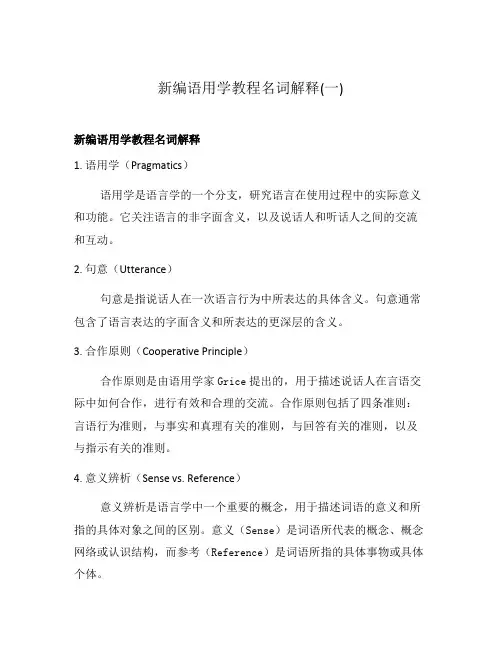
新编语用学教程名词解释(一)新编语用学教程名词解释1. 语用学(Pragmatics)语用学是语言学的一个分支,研究语言在使用过程中的实际意义和功能。
它关注语言的非字面含义,以及说话人和听话人之间的交流和互动。
2. 句意(Utterance)句意是指说话人在一次语言行为中所表达的具体含义。
句意通常包含了语言表达的字面含义和所表达的更深层的含义。
3. 合作原则(Cooperative Principle)合作原则是由语用学家Grice提出的,用于描述说话人在言语交际中如何合作,进行有效和合理的交流。
合作原则包括了四条准则:言语行为准则,与事实和真理有关的准则,与回答有关的准则,以及与指示有关的准则。
4. 意义辨析(Sense vs. Reference)意义辨析是语言学中一个重要的概念,用于描述词语的意义和所指的具体对象之间的区别。
意义(Sense)是词语所代表的概念、概念网络或认识结构,而参考(Reference)是词语所指的具体事物或具体个体。
5. 会话分析(Conversation Analysis)会话分析是语用学的一个分支,研究日常对话中的语言现象和互动模式。
通过分析人们的对话结构、交互方式和组织方式,会话分析可以揭示语境对对话的影响,并且可以理解对话中涉及的意义和目的。
6. 言外之意(Implicature)言外之意是指通过说话人的言辞外部暗示出的含义。
言外之意通常是通过推理和推导从言辞中推断出来的,而不是直接由言辞本身表达出来的。
7. 修辞(Rhetoric)修辞是语用学中的一个重要概念,指通过运用特定的语言手法和修辞技巧来增强说话人的语言表达的说服力和表现力。
修辞包括了比喻、夸张、反问等多种形式。
8. 语篇分析(Discourse Analysis)语篇分析是语用学的一个分支,研究文本和对话中的语言现象和语言结构。
通过分析语境、语言选择、句子结构等,语篇分析可以揭示文本或对话的含义、目的和影响。
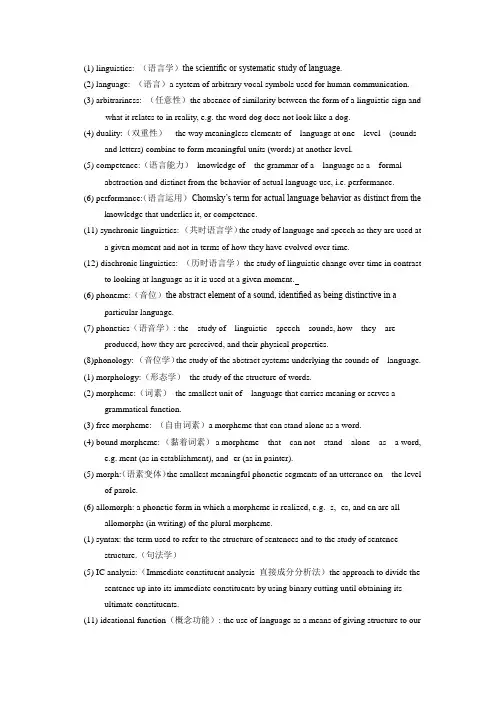
(1) linguistics: (语言学)the scientific or systematic study of language.(2) language: (语言)a system of arbitrary vocal symbols used for human communication.(3) arbitrariness: (任意性)the absence of similarity between the form of a linguistic sign andwhat it relates to in reality, e.g. the word dog does not look like a dog.(4) duality:(双重性)the way meaningless elements of language at one level (soundsand letters) combine to form meaningful units (words) at another level.(5) competence:(语言能力)knowledge of the grammar of a language as a formalabstraction and distinct from the behavior of actual language use, i.e. performance.(6) performance:(语言运用)Chomsky’s term for actual language behavior as distinct from theknowledge that underlies it, or competence.(11) synchronic linguistics: (共时语言学)the study of language and speech as they are used ata given moment and not in terms of how they have evolved over time.(12) diachronic linguistics: (历时语言学)the study of linguistic change over time in contrastto looking at language as it is used at a given moment.(6) phoneme:(音位)the abstract element of a sound, identified as being distinctive in aparticular language.(7) phonetics(语音学): the study of linguistic speech sounds, how they areproduced, how they are perceived, and their physical properties.(8)phonology: (音位学)the study of the abstract systems underlying the sounds of language.(1) morphology:(形态学)the study of the structure of words.(2) morpheme:(词素)the smallest unit of language that carries meaning or serves agrammatical function.(3) free morpheme: (自由词素)a morpheme that can stand alone as a word.(4) bound morpheme: (黏着词素)a morpheme that can not stand alone as a word,e.g. ment (as in establishment), and -er (as in painter).(5) morph:(语素变体)the smallest meaningful phonetic segments of an utterance on the levelof parole.(6) allomorph: a phonetic form in which a morpheme is realized, e.g. -s, -es, and en are allallomorphs (in writing) of the plural morpheme.(1) syntax: the term used to refer to the structure of sentences and to the study of sentencestructure.(句法学)(5) IC analysis:(Immediate constituent analysis 直接成分分析法)the approach to divide thesentence up into its immediate constituents by using binary cutting until obtaining itsultimate constituents.(11) ideational function(概念功能): the use of language as a means of giving structure to ourexperience of the real or imaginary world.(12) interpersonal function(人际功能): the use of language for maintaining social roles andinteracting with others.(13) textual function(语篇功能): to create written or spoken texts which cohere withinthemselves and which fit the particular situation in which they are used.(1) semantics: the study of linguistic meaning.语义学(14) synonymy:(同义) the sense relations of equivalence of meaning between lexicalitems, e.g. small/little and dead/deceased.(15) antonymy:(反义关系) the sense relation of various kinds of opposing meaning betweenlexical items, e.g. big/small, alive/dead and good/bad.(16) hyponymy:(上下义关系)the sense relation between terms in a hierarchy,where a more particular term (the hyponym) is included in the more general one (thesuperordinate): X is a Y, e.g. a beech is a tree, a tree is a plant.(17) meronym:(整体部分关系)the sense relation between body and its parts which are notonly sections of the body but defined in terms of specific functions. For example, thehead is the part of the body which carries the most important sense organs, i.e. eyes, ears, nose and tongue.(1) pragmatics:(语用学)a branch of linguistics that studies language in use.(2) deixis:(指示)the marking of the orientation or position of entities and situations withrespect to certain points of reference such as the place (here/there) and time (now/then) of utterance.(1) sociolinguistics: the study of the relationship between language and society, that is, howsocial factors influence the structure and use of language.(社会语言学)(8) diglossia:(双语) a situation when two distinct varieties of the same languageare used, side by side, for two different sets of functions.(9) bilingualism:(双语现象)the use of at least two languages either by an individual or by agroup of speakers, such as the inhabitants of a particular region or a nation.(11) taboo:(禁忌)a word or expression that is prohibited by the polite society from generaluse.(12) euphemism:(委婉语)a word or phrase that replaces a taboo word or is used to avoidreference to certain acts or subjects, e. g. “powder room” for “toilet”.(1) cognitive linguistics: a new approach to the study of language and mind. According to thisapproach, language and language use are based on our bodily experience and the way we conceptualize it.(认知语言学)。
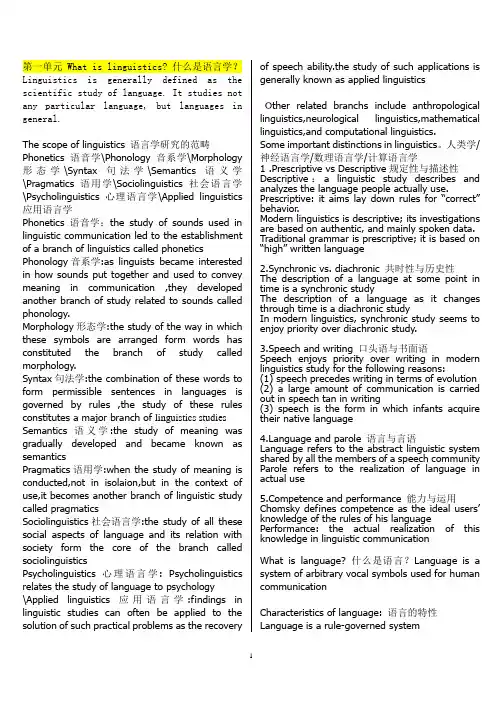
第一单元What is linguistics? 什么是语言学?Linguistics is generally defined as the scientific study of language. It studies not any particular language, but languages in general.The scope of linguistics 语言学研究的范畴Phonetics语音学\Phonology音系学\Morphology 形态学\Syntax句法学\Semantics语义学\Pragmatics语用学\Sociolinguistics社会语言学\Psycholinguistics心理语言学\Applied linguistics 应用语言学Phonetics语音学:the study of sounds used in linguistic communication led to the establishment of a branch of linguistics called phonetics Phonology音系学:as linguists became interested in how sounds put together and used to convey meaning in communication ,they developed another branch of study related to sounds called phonology.Morphology形态学:the study of the way in which these symbols are arranged form words has constituted the branch of study called morphology.Syntax句法学:the combination of these words to form permissible sentences in languages is governed by rules ,the study of these rules constitutes a major branch of linguistics studies Semantics语义学:the study of meaning was gradually developed and became known as semanticsPragmatics语用学:when the study of meaning is conducted,not in isolaion,but in the context of use,it becomes another branch of linguistic study called pragmaticsSociolinguistics社会语言学:the study of all these social aspects of language and its relation with society form the core of the branch called sociolinguisticsPsycholinguistics心理语言学: Psycholinguistics relates the study of language to psychology\Applied linguistics应用语言学:findings in linguistic studies can often be applied to the solution of such practical problems as the recovery of speech ability.the study of such applications is generally known as applied linguisticsOther related branchs include anthropological linguistics,neurological linguistics,mathematical linguistics,and computational linguistics.Some important distinctions in linguistics。
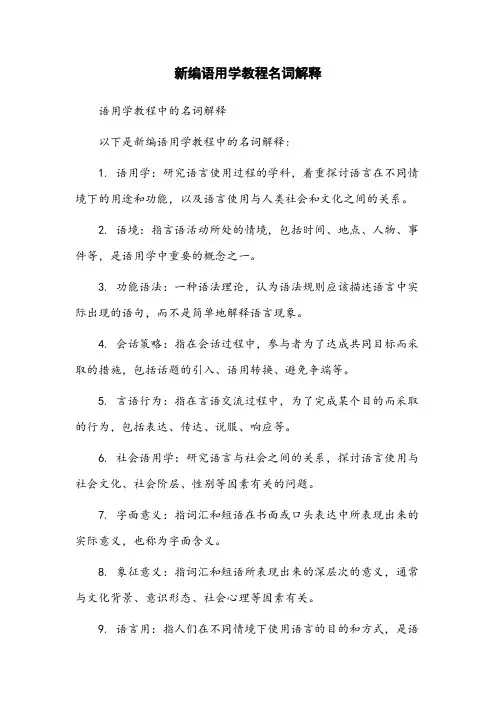
新编语用学教程名词解释
语用学教程中的名词解释
以下是新编语用学教程中的名词解释:
1. 语用学:研究语言使用过程的学科,着重探讨语言在不同情境下的用途和功能,以及语言使用与人类社会和文化之间的关系。
2. 语境:指言语活动所处的情境,包括时间、地点、人物、事件等,是语用学中重要的概念之一。
3. 功能语法:一种语法理论,认为语法规则应该描述语言中实际出现的语句,而不是简单地解释语言现象。
4. 会话策略:指在会话过程中,参与者为了达成共同目标而采取的措施,包括话题的引入、语用转换、避免争端等。
5. 言语行为:指在言语交流过程中,为了完成某个目的而采取的行为,包括表达、传达、说服、响应等。
6. 社会语用学:研究语言与社会之间的关系,探讨语言使用与社会文化、社会阶层、性别等因素有关的问题。
7. 字面意义:指词汇和短语在书面或口头表达中所表现出来的实际意义,也称为字面含义。
8. 象征意义:指词汇和短语所表现出来的深层次的意义,通常与文化背景、意识形态、社会心理等因素有关。
9. 语言用:指人们在不同情境下使用语言的目的和方式,是语
用学中的一个重要概念。
10. 语言结构:指语言中词语和句子的排列和组合方式,是语法学中的核心概念之一。
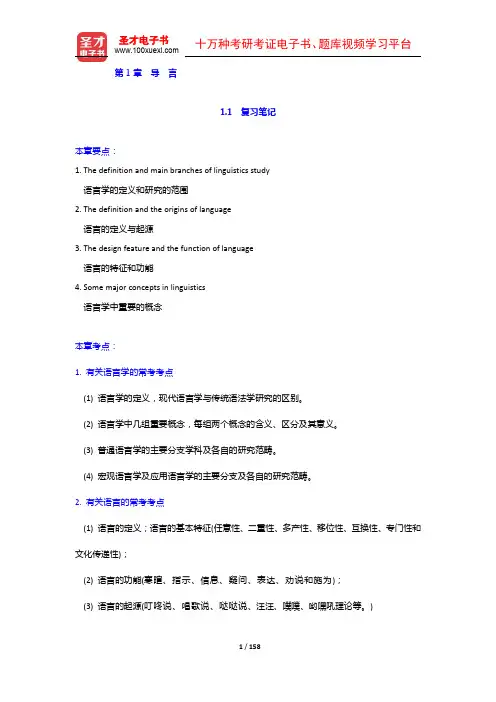
第1章导言1.1复习笔记本章要点:1.The definition and main branches of linguistics study语言学的定义和研究的范围2.The definition and the origins of language语言的定义与起源3.The design feature and the function of language语言的特征和功能4.Some major concepts in linguistics语言学中重要的概念本章考点:1.有关语言学的常考考点(1)语言学的定义,现代语言学与传统语法学研究的区别。
(2)语言学中几组重要概念,每组两个概念的含义、区分及其意义。
(3)普通语言学的主要分支学科及各自的研究范畴。
(4)宏观语言学及应用语言学的主要分支及各自的研究范畴。
2.有关语言的常考考点(1)语言的定义;语言的基本特征(任意性、二重性、多产性、移位性、互换性、专门性和文化传递性);(2)语言的功能(寒暄、指示、信息、疑问、表达、劝说和施为);(3)语言的起源(叮咚说、唱歌说、哒哒说、汪汪、噗噗、哟嘿吼理论等。
)本章内容索引:I.Definition of linguisticsII.Linguistics vs.traditional grammarIII.Scope of linguistics1.Microlinguistics2.MacrolinguisticsIV.Definition of languageV.Origins of language1.Ding-Dong Theory2.Sing-Song Theory3.Pooh-Pooh Theory4.Yo-He-Ho Theory5.Ta-Ta Theory6.Bow-Wow TheoryVI.Design features of language1.Arbitrariness2.Duality3.Productivity4.Interchangeability5.Displacement6.Specialization7.Cultural transmissionVII.Functions of language1.Phatic function/communion2.Directive functionrmative function4.Interrogative function5.Expressive function6.Evocative function7.Performative functionVIII.Some major concepts in linguistics1.Descriptive and prescriptive grammar2.Synchronic and diachronic linguisticsngue and parolepetence and performance5.Syntagmatic and paradigmatic relations6.Functionalism and formalismI.Definition of linguistics(语言学的定义)【考点:名词解释】The scientific or systemic study of language,which is always guided by the-three canons ofscience:exhaustiveness,consistency and economy.语言学是对语言的科学或系统的研究。
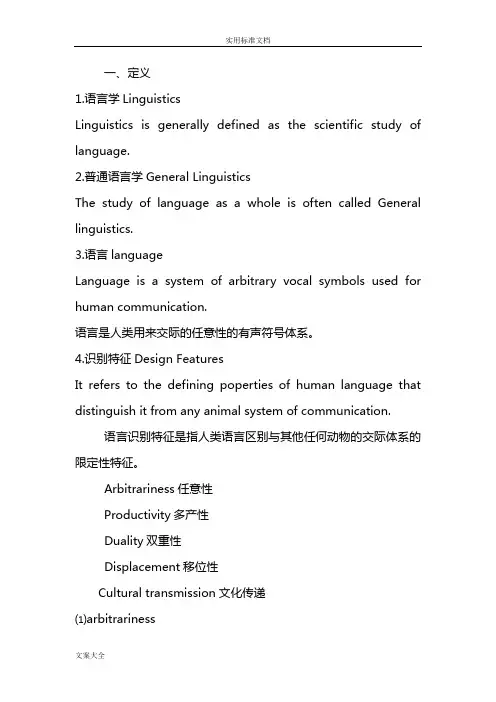
一、定义1.语言学LinguisticsLinguistics is generally defined as the scientific study of language.2.普通语言学General LinguisticsThe study of language as a whole is often called General linguistics.3.语言languageLanguage is a system of arbitrary vocal symbols used for human communication.语言是人类用来交际的任意性的有声符号体系。
4.识别特征Design FeaturesIt refers to the defining poperties of human language that distinguish it from any animal system of communication.语言识别特征是指人类语言区别与其他任何动物的交际体系的限定性特征。
Arbitrariness任意性Productivity多产性Duality双重性Displacement移位性Cultural transmission文化传递⑴arbitrarinessThere is no logical connection between meanings and sounds. P.S the arbitrary nature of language is a sign of sophistication and it makes it possible for language to have an unlimited source of expressions⑵ProductivityAnimals are quite limited in the messages they are able to send.⑶DualityLanguage is a system, which consists of two sets of structures ,or two levels.⑷DisplacementLanguage can be used to refer to contexts removed from the immediate situations of the speaker.⑸Cultural transmissionHuman capacity for language has a genetic basis, but we have to be taught and learned the details of any language system. this showed that language is culturally transmitted. not by instinct. animals are born with the capacity to produce the set of calls peculiar to their species.5.语言能力CompetenceCompetence is the ideal user’s knowledge of the rules of his language.6.语言运用performancePerformance is the actual realization of this knowledge in linguistic communication.语言运用是所掌握的规则在语言交际中的体现。
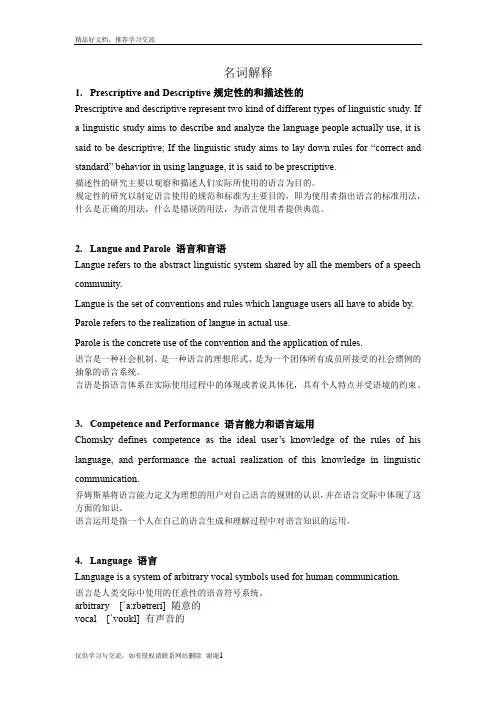
名词解释1.Prescriptive and Descriptive规定性的和描述性的Prescriptive and descriptive represent two kind of different types of linguistic study. If a linguistic study aims to describe and analyze the language people actually use, it is said to be descriptive; If the linguistic study aims to lay down rules for “correct and standard” behavior in using language, it is said to be prescriptive.描述性的研究主要以观察和描述人们实际所使用的语言为目的。
规定性的研究以制定语言使用的规范和标准为主要目的,即为使用者指出语言的标准用法,什么是正确的用法,什么是错误的用法,为语言使用者提供典范。
ngue and Parole 语言和言语Langue refers to the abstract linguistic system shared by all the members of a speech community.Langue is the set of conventions and rules which language users all have to abide by. Parole refers to the realization of langue in actual use.Parole is the concrete use of the convention and the application of rules.语言是一种社会机制、是一种语言的理想形式、是为一个团体所有成员所接受的社会惯例的抽象的语言系统。
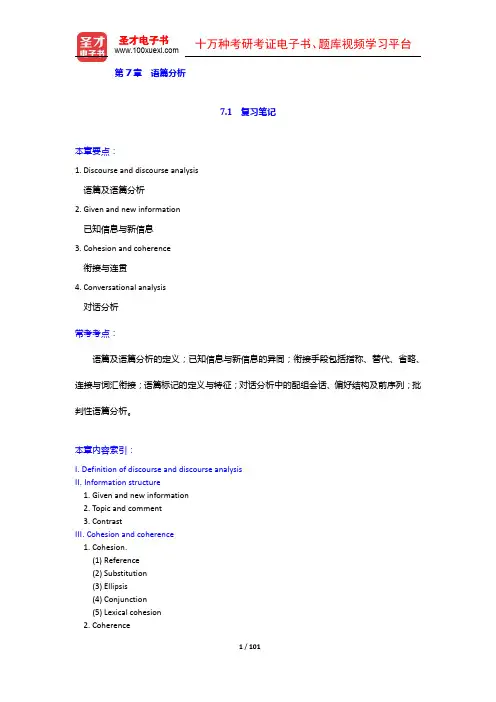
第7章语篇分析7.1复习笔记本章要点:1.Discourse and discourse analysis语篇及语篇分析2.Given and new information已知信息与新信息3.Cohesion and coherence衔接与连贯4.Conversational analysis对话分析常考考点:语篇及语篇分析的定义;已知信息与新信息的异同;衔接手段包括指称、替代、省略、连接与词汇衔接;语篇标记的定义与特征;对话分析中的配组会话、偏好结构及前序列;批判性语篇分析。
本章内容索引:I.Definition of discourse and discourse analysisrmation structure1.Given and new information2.Topic and comment3.ContrastIII.Cohesion and coherence1.Cohesion.(1)Reference(2)Substitution(3)Ellipsis(4)Conjunction(5)Lexical cohesion2.CoherenceIV.Discourse markers1.Definition2.Functional-pragmatic nature3.Features of discourse markersV.Conversational analysis1.Adjacency pairs2.Preference structure3.PresequencesVI.Critical discourse analysisI.Definition of discourse and discourse analysis(语篇及语篇分析的定义)1.Discourse(语篇)A general term for examples of language use,nguage which has been produced as the result of an act of communication.It refers to the larger units of language such as paragraphs, conversations,and interviews.泛指语言的运用,也就是说,语篇是人们进行交流的产物。
1.1 Linguistics is generally defined as the scientific study of language.It is a scientific study because it (a) is based on the systematic investigation of linguistic data. It (b) discovers the nature and rules of the underlying language system. It (c) collects language facts that display some similarities, and generalizations are made about them.The study of language as a whole if often called general linguistics.phonetics(语音学): the study of soundsphonology(音位学): how sounds are put together and used to convey meaningmorphology(形态学): how morphemes(词素) are arranged and combined to form wordssyntax(句法学): the study of rules that govern the combination of words to form grammaticallypermissible sentencessemantics(语义学): the study of meaningpragmatics(语用学): the study of meaning in the context of language useinterdisciplinary branches: sociolinguistics(社会语言学), psycholinguistics(心理语言学), applied linguistics(应用语言学)Important distinctions in linguisticsprescriptive(规定性old linguistics) vs. descriptive(描述性modern linguistics)synchronic(共时性) vs. diachronic(历时性): most linguistic studies are of synchronic descriptions,which is prior in modern linguisticsspeech and writing: speech is prior to writing in modern linguisticslangue(语言系统abstract linguistic system) and parole(话语/言语realization of langue in actualuse): Swiss linguist F. de Saussure----forefather of modern linguisticscompetence(语言能力ideal user’s knowledge of rules of his language) and performance(语言运用actual realization of this knowledge): American linguist N. Chomskytraditional grammar and modern linguistics: Saussure’s book “Course in General Linguistics”marked the beginning of modern linguistics1.2 Language is a system of arbitrary vocal symbols used for human communication.LAD: Language Acquisition Device -----ChomskyArbitrariness (任意性): Different sounds are used to refer to the same object in different languages.Productivity/creativity (能产性): Construction and interpretation of new signals are possible, so that large number of sentences can be produced.Duality (双层性): Two levels enable people to talk about anything within their knowledge. lower level(sounds)---higher level(words)Displacement(移位性): enable people to talk about a wide range of things, free from barriers caused by separation in time or place.Cultural transmission(文化传承): We are born with the ability to acquire language, the details of language system have to be taught and learned.2.1 Speech and writing are the two media for communication, of which speech ismore basic/primary.The sounds which are produced by humans through their speech organs and meaningful in communication constitute the phonic medium of language. The individual sounds within this range are the speech sounds.2.2 Phonetics is the study of the phonic medium of language, which concerned with all the sounds thatoccur in the world’s languages.articulatory phonetics, auditory phonetics, acoustic phoneticsSpeech organs:pharyngeal; cavity---throat; oral cavity---mouth; nasal cavity---noseIPA: 国际音标diacritics: 变音符broad transcription: 宽式标音(used in dictionaries and teaching textbooks)narrow transcription: 严式标音(used by phoneticians in their study)vowels(the air stream meets with no obstruction) and consonants(obstructed)stops(塞音), fricatives(擦音), affricates(塞擦音), liquids(流音), nasals, glides, bilabial(双唇音), laviodental(唇齿音), dental(齿音), alveolar(齿龈音), palatal(腭音), velar(软腭音), glottal(喉音)close vowels, semi-close vowels, semi-open vowels, open vowels(openness)unrounded vowels, rounded vowels(shape of the lips)long/tense vowels----short/lax vowelsmonophthongs(单元音), diphthongs(双元音) (single or combined)2.3 Phonology and phonetics differ in their approach and focus.phonology: how speech sounds form patterns and are used to convey meaningconcerned with sound system of a particular languagephonetics: of a general nature, interested in all the speech soundsA phone(音素) is a phonetic unit or segment.(speech sounds are all phones)a phone does not necessarily distinguish meaningA phoneme(音位) is a phonological unit.(an abstract unit of distinctive value)not particular sound, but is realized by a certain phone in a certain phonetic context The different phones which can represent a phoneme in different phonetic environments are called the allophones(音位变体) of that phoneme.Rules in phonology:Sequential rules(序列规则)---rules that govern the combination of sounds in a particular language.Assimilation rule(同化规则)---assimilates one sound to another by “copying”a feature of a sequential phoneme, thus making the two phones similar. for ease of articulation(清晰发音)e.g. green, screamDeletion rule(省略规则)---e.g. desi g nationSuprasegmental features(超切分特征): the phonemic features that occur above the level of the segments.stress(重音)---word stress and sentence stressThe location of stress in English distinguishes meaning.E.g. ‘import (n.) im’port (v.) // blackbird vs. black birdtone(语调)---pitch variation(音高变体) distinguish meaning E.g. 汉语四声Intonation(音调)---English tones: falling tone, rising tone, fall-rise tone, rise-fall toneE.g. That’s not the book he wants.3.1 Morphology: study of the internal structure of words, and rules by which words are formed3.2 open class words(开放类): new words can be added—nouns, verbs, adjective and adverbsclosed class words(封闭类): “grammatical” or “functional” words3.3 Word is the smallest free form found in language.Morphemes are the minimal units of meaning.Free and bound morphemes(自由词素can be a word by itself粘着词素must be attached to another one---affix)3.4 V----teachN Af----er3.5 Derivational and inflectional morphemes(派生词素和屈折词素)Free morphemes Bound morphemesRoot Root Affixdog, cat -ceive Prefix Suffixgrammar -vert Derivational Derivational Inflectional …-mit un-, dis- -ment -s, -ing, -‘s, -er3.6 Morphological rules determine how morphemes combine to form words. E.g. un-accept-able3.8 Another way to form words is compounding. E.g. bittersweetWord Formations: compounding, blending, backformation, shortening4.1 Syntax studies the rules that govern the formation of sentences.4.2 Category is a group of linguistic items which fulfill the same or similar functions in a particular languagesuch as a sentence, a noun phrase or a verb.Syntactic categories—word-level categories:major lexical categories (often assumed as the heads around which phrases are built)---Noun (N) Verb (V) Adjective (A) Preposition (P)minor lexical categories---Determiner (Det) Degree words (Deg) Qualifier (Qual) Auxiliary (Aux) Conjunction (Con)Three criteria(条件) determining a word’s category: meaning, inflection (变形) and distribution (分布)A word’s category can be determined only by all three criteria.Phrase category is determined by the word category around which the phrase is built.noun phrase (NP), verb phrase (VP), adjective phrase (AP), prepositional phrase (PP)phrases that are formed of more than one word usually contain : head, specifier, complement4.3 Phrase structure rule---special type of grammatical mechanism regulating the arrangement of elementsthat make up a phraseNP→(Det) N (PP) an NP consists of a determiner, an N head, and a PP complementVP→(Qual) V (NP) a VP consists of a qualifier, a V head, and an NP complementAP→(Deg) A (PP) ……PP→(Deg) P (NP) ……XP rule: XP→(specifier) X (complement)Coordination rule: coordinate structures (consist a conjunction “and”/”or”)X→X *Con XEither an X or an XP can be coordinated; one or more categories can occur to the left of the Con.4.4 Phrase elements: specifiers, complements, modifiersspecifiers determiner qualifier degree wordheads N V A / Pcomplementizers (Cs)—words introducing the sentence complementcomplement clause—sentence introduced by the complementizer complement phrase(CP)matrix clause—construction in which the CP embeded嵌入As, Ns, Ps can all take CP. Adjectives: (heads) afraid, certain, awareNouns: (heads) fact, claim, belief Prepositions: (heads)over, aboutmodifiers: all lexical categories can have modifiers.AP(+Ns): precedes the head e.g. a very careful girl PP(+Vs): follows the head e.g. open with care AdvP(+Vs): precedes or follows the head e.g. read carefully/carefully readThe Expanded XP rule: XP→(Spec) (Mod) X (Complement*) (Mod)4.5 The S rule: S→NP VP ------ Inflp (=S)→NP Infl VP ------Infl can be taken by an abstract category encodedin a verb indicating tense or an auxiliary(助动词)4.6 Transformation a special rule that can move an element from one position to anotherauxiliary movement(助动词移位) inversion: move Infl to the left of the subject NP.within larger CPs (embedded or not): inversion: move Infl to C. P53 Figure 4-8 do insertion(插入): insert interrogative do into an empty Infl position, than move Infl to C.deep and surface structure: e.g. Will the train arrive?Deep: S Surface:NP VPDet Infl Vthe train will arriveThe XP rule→D structure→transformations→S structurewh movement: move the wh phrase to the beginning of the sentence/the specifier position under CPP57 Figure 4-16 P58 Figure 4-18move αand constraints on transformationsmove α: general rule for all the movement rules α: any element that can be movedlimits: inversion can move an auxiliary from the Infl to the nearest C positionno element may be removed from a coordinate structure5.1 Semantics is the study of meaning (from a linguistic point of view.)5.2 The naming theory: The words used in a language are simply labels of the objects they stand for.The limitations of this theory are obvious. There’s verbs, adjectives, etc. and also abstract nouns.The conceptualist view: Words and things are related through the mediation of concepts in the mind.Contextualism: The meaning of a word is its use in the language.Behaviorism: The meaning of a language form is the situation in which the speaker utters it and the response it calls forth in the hearer.5.3 Sense and reference are two terms often encountered in the study of word meaning, which are relatedbut different aspects of meaning.Sense: e.g. “dog”---a domesticated mammal... refer to any animal that meets the features described Reference: “dog”---A said to B:” The dog’s barking.”refer to a certain dog known to both A&BMajor sense relations:synonymy---words that are close in meaningdialectal syn.(autumn in BE & fall in AE), stylistic syn.(daddy & father),syn. that differ in emotive or evaluative meaning(same meaning, different emotions)collocational syn.(different usage), semantically different syn.(differ slightly in meaning) polysemy(one word may have more than one meaning)homonymy (homophones--- two words same in sound, homographs---same in spelling, complete homonyms---same in both sound and spelling)hyponymy(relation between a general word—superordinate, and a specific word--hyponyms)antonymy(words that are opposite in meaning)gradable ant.---e.g. hot vs. cold complementary ant.---e.g. male vs. femalerelational ant.---e.g. husband vs. wife5.4 Sense relations between sentences:X is synonymous with Y. E.g. He was a bachelor all his life. / He never married….X, True—Y, True; X, False---Y FalseX is inconsistent with Y. E.g. John’s married. / John’s a bachelor. X, T—Y, F; X, F—Y, TX entails Y. E.g. He’s been to France. / He’s been to Europe. X, T—Y, T; X, F—Y, may be T or FX presupposes Y. E.g. John’s bike needs repairing. / John has a bike. X, T—Y, T; X, F—Y, TX is a contradiction. E.g. My unmarried sister married a bachelor. X is always false.X is semantically anomalous. (absurd in the sense)5.5 componential analysis----lexical meaning E.g. man---+HUMAN, +ADULT, +ANIMATE, +MALEpredication(谓项) analysis---sentence meaning E.g. The kids like apples. ---KID, APPLE (LIKE) Tom smokes. ---TOM (SMOKE) It is hot. --- (BE HOT)6.1 Pragmatics studies how speakers of a language use sentences to effect successful communication(meaning in a certain context).Sentence meaning vs. utterance meaningUtterance is the realization of the abstract meaning of a sentence in a real situation of communication or context, it is context-dependent.6.2 Speech act theory: aim to answer “What do we do when using language?”----John Austin in late 1950slocutionary act(言内行为—字面意思), illocutionary act(言外行为—目的), perlocutionary act(言后行为—结果) John Searle: classification of illocutionary acts---five general types of things we do with languageSpecific acts that fall into each type share the same illocutionary point1. representatives/assertive: stating or describing, saying what the speaker believes to be trueE.g. The earth is a globe.2. directives: trying to get the hearer to do something E.g. Close the door. / Will you close the door?3. commissives: committing the speaker himself to some future course of actionE.g. I promise to come. / I will bring you the book tomorrow without fail.4. expressive: expressing feelings or attitude towards an existing stateE.g. It’s kind of you to ... / I’m sorry for the mess I’ve made.5. declarations: bringing about immediate changes by saying somethingE.g. I now declare the meeting open. / I appoint you chairman of the committee.Indirect speech act--primary speech act (goal of communication) + secondary speech act (means by which he achieves the goal) ----Searle6.3 Conventional implicature(暗示) & nonconventional implicature-----GriceCon. imp. E.g. He is rich but he is not greedy. imp. Rich people are usually greedy.The participants must first of all be willing to cooperate to converse with each other. The general principle is called the Cooperative Principle. (CP)Four maxims(准则) under CP: The maxim of quantity (informative but no more than required), quality (don’t say what you believe to be false or what you lack adequate evidence), relation (be relevant), manner (avoid obscurity or ambiguity & be brief and orderly)These maxims can be violated. (when misleading, lying, etc.)Chap. 7 Language change (diachronic 历时的) Historical linguisticsphonological changes: vowels---the most dramatic changemorphological and syntactic change:morphological: Addition of affixes (Fusion 融合word word---base +suffix /prefix +base)Loss of affixes---some are via sound changessyntactic: change of word order Old English: subject-object-verbchange in negation rule Old English: I love thee not.lexical and semantic change:lexical: Addition of new words---takes place obviously and quicklyCoinage (coin for new things and objects), Clipped words (缩略构词),Blending (combine parts of other words, e.g. brunch),Acronyms (首字构词e.g. WTO),Back-formation (subtract affixes from old words, e.g. donate---from “donation”)Functional shift /Conversion (shift without adding affixes, e.g. to knee/cool; a reject)Borrowing (borrow from other languages, e.g. bonus from Latin, cycle from Greek…)Loss of words---takes place gradually over several generationsSome words are short-lived because of the discontinuation of the object they name.semantic: three processes of semantic change---semantic broadening: e.g. holiday = holy day in the past, but any rest day todaysemantic narrowing: e.g. girl = young person of either sex in the pastsemantic shift: e.g. nice = ignorant a thousand years agorecent trends: moving towards greater informality, influence of American English,influence of science and technology (space travel, computer and internet lang. etc.) causes of language change: development of science &tech., social & political changes and needs,the way children acquire language, grammar simplification, elaboration &complication, etc. No single causeChap. 8 Language and societySociolinguistics is the sub-field of linguistics that studies the relation between language and society, between the uses of language and the social structures in which the users of languagelive. (社会语言学) Halliday & HudsonLanguage is used to communicate meaning, and to establish and maintain social relationships.Social background determines the kind of language one uses, and language reflects one’s info.speech community---the social group that is singled out for any special studyVarious social groups exist within a speech community. A social group may distinguish itself fromthe rest of the community by the educational background, the occupation, the gender, the age ,of the ethnic affiliation of its members.speech variety(变体)---any distinguishable form of speech used by a speaker or a group of speakersthree types of speech variety of special interest: regional dialects, sociolects, registersTwo approaches to sociolinguistic studies: macro-sociolinguistics & micro-sociolinguisticsThe varieties of language are related to the users and the use to which the language is put.Dialectal varieties: regional dialect (linguistic variety used by people living in the same geographical region---geographical barrier), sociolect (characteristic of a particular socialclass---different social conditions), language and gender (female speech is less assertive andthus sounds more polite), language and age (old people are more conservative and like usingold words more), idiolect (personal dialect), ethnic dialect (social dialect of a languagecutting across regional differences e.g. Black English)Register: the type of language which is selected as appropriate to the type of situation linguistic repertoire---the totality of linguistic varieties possessed by an individualthree social variables that determine the register(the features appropriate to the situation): field of discourse (语场purpose and subject-matter of communication non-technical or technical, determines the vocabulary used and the phono. & gramm. features), tenor of discourse (语旨who the participants are and the relationship between them determines the formality and the level of technicality),mode of discourse(语式the means of communication)E.g. a lecture on biology in a technical collegeField: scientific (biological) Tenor: teacher—student (formal, polite) Mode: oral (lecturing) Degree of formality: intimate—casual—consultative—formal—frozenStandard dialects (employed by government, used by mass media, taught in edu. institutions, based on a selected variety of lang., usually local speech of political or commercial centers,for official purposes or any formal occasions)Pidgin (a variety that mixes or blends languages) and Creole (a pidgin becoming the primary lang.of a speech community of which the children acquire the pidgin as native lang.)Chap. 9 Language and culture are interdependent on each other and have evolved together.Culture is integrated pattern of human knowledge, belief, & behavior. (material & spiritual cult.) Relationship between lang. &cult. : Language symbolizes cultural reality, plays a major role in perpetuating of a culture, is related to what the culture is and affects a culture’s way ofthinking. Language is to culture what part is to whole.discourse communities--- members of the social group use similar lang. to meet their needsdiscourse accents---unique uses of each group’s language, the ways and the style of their talking Sapir-Whorf Hypothesis (SWH): Language filters people’s perception and the way they categorize their experiences.Language reflects cultural preoccupations and constrains the way people think.Context is important in complementing the meanings encoded in the language.Any linguistic sign has a denotative (指示意义—内含), connotative (暗涵意义—外延), or iconic(图像意义) kind of meaning. All these types of meanings are bound with cultural encodings orassociations.some cultural differences in language use: greeting and terms of address, gratitude and compliments, color words, privacy and taboos(禁忌), rounding off numbers, words andcultural specific connotations, cultural-related idioms, proverbs and metaphors Culture contact--- acculturation(文化移入political conquests and expansions), assimilation (吸收immigration), amalgamation (合并ethnical mix / synthesis rather than the elimination orabsorption)Cultural overlap (文化重叠owe to similarities in natural environ. and human psychology)Cultural diffusion (文化扩展e.g. loan words gradually and unceasingly)cultural imperialism (文化帝国主义)---owe to linguistic imperialismspecial language policy protecting the purity of their languages---linguistic nationalism Chap. 10 Language acquisition---child’s acquisition of his mother tongueThree theories: the behaviorist (行为主义语言习得观), the innatist(语法天生…),the interactionist (互动主义…)Behaviorist: language is a kind of behavior, language learning is simply a matter of imitation and habit formation. Children imitate words selectively and according to their ownunderstanding of the sounds or patterns, which is based on what the children have alreadyknown instead of what is “available” in the environment. This theory fails to explain howthey acquire more complex grammatical structures of the languageInnatist: LAD was described as an imaginary “black box” existing somewhere in the human brain.It is said to contain principles that are universal to all human languages.Universal Grammar: innate knowledge of basic grammatical systemChildren ‘s acquisition of grammatical rules is guided by principles of an innate UG.Interactionist: language is a result of the complex interplay between the human characteristics of the child and the environment in which he grows.child directed speech (CDS)(slow rate, high pitch音高, rich intonation抑扬, shorter andsimpler sentence structure)The cognitive development relates to language acquisition mainly in two ways:First, as children’s conceptual development leads to their language development, theirlanguage development also helps in the formation and enhancement of the concept.Second, the cognitive factors determine how the child makes sense of the linguistic systemhimself instead of what meanings the child perceives (理解) and expresses.Two factors remarkably relevant to children’s language developmentLanguage environment is essential in providing input for language acquisition:Behaviorist: language environment plays a major roleInnatist: environment is a stimulus that triggers the pre-equipped LADInteractionist: call for the quality of the language samples available in the ling. environmentAge they start to learn the language:Critical Period Hypothesis (CPH): LAD works successfully only when it’s stimulated at the righttime—a specific and limited time period for language acquisition (Eric Lenneberg)Two versions of CPH: strong one—children must acquire their first language by pubertyweak one—language learning will be more difficult and incomplete after puberty ----consensus: there’s a critical period for first language acquisitionStages in child language development:Phonological development—children must pass one stage before proceeding to the nextVocabulary development—under-extension, over-extensionVocabulary development goes together with the child’s knowledge of the environment.Children may under-extend or overextend it when learning a new word.under-extension: e.g. child gets confused hearing the color of white used for paper when he first thought it as the word for snowover-extension: a child takes a property of an object and generalizes it. likely to occur later Grammatical developmentPragmatic developmentAtypical development (非典型发展)hearing impairment (听力损伤), mental retardation (智力缺陷), autism (孤独症), stuttering(口吃), aphasia (失语症), dyslexia (诵读困难), dysgraphia (书写困难)Chap. 11 Second language acquisition (SLA) is the systematic study of how one person acquires a second language subsequent to his native language (NL/L1).Whether the target language (TL) to be learnt is called a second language (SL/L2) or a foreignlanguage (FL) depends on its status as a second language or foreign language in the country.Contrastive Analysis (CA)--1960s :positive/negative transfer: the former facilitate target language learning, the latter interfereCA compares the forms and meanings across two languages to locate the mismatches or differences so as to predict the possible learning difficulty.It was soon found problematic: uninformative, inaccurateError Analysis (EA): independently describe the learners’ interlanguage (their version of the target language and the target language itself), and compare the two forms to locate mismatches.It gives less consideration to learner s’ native language than CA. reach heyday in 1970sTwo main sorts of errors: interlingual errors (语际错误result from cross-linguistic interferenceat different levels—phonological, lexical…), intralingual errors (语内错误result from faultyor partial learning of the TL, independent of the NL e.g. learning strategies-based error)Overgeneralization—the use of previously available strategies in new situationsCross-association—interference of two words similar in meaning, spelling and pronunciationEA was criticized for its neglect of learners’ role as active participants in learning. (mid-1970s)Interlanguage: Three important characteristics—systematicity (系统性), permeability (渗透性), fossilization (石化a process occurring from time to time in which incorrect linguistic features become apermanent part of the way a person speaks or writes a language. fossilized pronunciation leads to accent) Input Hypothesis---Krashen: two independent means or routes of second language learning: acquisition: subconscious process learning: conscious effortsLearners advance their language learning gradually by receiving “comprehensible input”. ”i+1”It received criticism later, for he mistook “input” as “intake”.Individual differences: language aptitude (天资), age of acquisition, personalitymotivation----instrumental motivation (for external goal), integrative motivation (for the wish toidentify with the target culture), resultative motivation (for external purposes), intrinsicmotivation (for pleasure),learning strategies (motivation plays an important role in use of learning strategies)----cognitive strategies (认知策略involved in analyzing, synthesizing(合成) and internalizing(内在化) what has been learned), metacognitive strategies (元认知策略the techniques inplanning, monitoring and evaluating one’s learning), affect/social strategies (deal with theways learners interact or communicate with other speakers, native or non-native)Chap. 12 Language and the brainneurolinguistics (神经语言学): study of language disorders and the relationship between the brain and language. lateralization (侧化)—cognitive functions controlled by either side of the brainThe brain is divided into two sections:the lower section—brain stem(脑干shared by all animals to keep the body alive by maintaining the essential functions)the higher section—cerebrum(大脑differs in different species, not essential for life)cerebellum—at the rear of the brain , beneath the cerebrum, behind the brainstemneuron神经元Neurons form the cortex(脑皮层the surface of the brain)The cortex has many wrinkles: a ridge (hills) called sulcus, a deep and prominent sulcus called fissure The cortex is the decision-making organ of the body and “storehouse” of “memory”, it makes human distinctive in the animal world—animals have no cortex.The cortex is separated by the longitudinal fissure into the left and right cerebral hemispheres, the。
新编语言学教程刘润清重点笔记一、语言学的基本概念1. 语言学的定义语言学是研究人类语言的科学,旨在探讨语言的结构、功能、演变和使用规律。
2. 语言的特征语言具有多样性、可变性、创造性和交际性等特征,是人类文化和社会生活的重要组成部分。
3. 语言的层次结构语言包括语音、词汇、句法、语义和语用等层次结构,每个层次相互交织,共同构成了具体的语言系统。
二、语音学1. 语音和语音学的基本概念语音是语言的声音表现形式,语音学是研究语音的学科,主要包括语音的产生、分类和规律等内容。
2. 语音的分类语音可以根据发音部位、发音方法和语音特征进行分类,这些分类对于理解不同语言的语音现象具有重要意义。
3. 语音的运用语音系统是语言的基础,正确、标准的语音能够促进交际的顺利进行,也是语音教学的重要内容。
三、语音变化规律1. 语音演变的观点语音演变是语言发展的必然规律,主要有自然演变和人为干预两种形式。
2. 语音演变的原因语音演变的原因有内在原因和外在原因两类,其中心理因素和社会因素是主要的影响因素。
3. 语音演变的类型语音演变的类型包括同化、咀嚼、发音简化、重音移位和音位交替等,这些类型在不同语言中都有所体现。
四、词汇学1. 词汇的概念词汇是语言中最基本的语言单位,包括单词和词组两种形式,构成了语言的基本载体。
2. 词与词的关系词的构词规律和词的语义关系是词汇学的重要研究内容,也是词汇教学中需要重点关注的问题。
3. 词的分类词可根据词性、构词法、语义感情色调和语言长短等属性进行分类,不同的分类体系能够为语言的学习和教学提供指导。
五、句法学1. 句法结构的基本要素句法结构主要包括主语、谓语、宾语等要素,这些要素之间的组合形式决定了句子的结构类型。
2. 句法关系的层次结构句法关系包括层级结构和包含关系,这些关系是句子语法结构的重要组成部分。
3. 句法结构的功能句法结构的功能包括构句、分句和复句等,这些功能是语法结构的基本表现形式。
新编简明英语语言学知识点汇总1 Introduction1.1 What is linguistics?Scientific study of language.Interpretation:①try to answer the basic questions and probe into various problems related to language;②linguistics studies not any particular language but language in general;③scientific study because based on systematic investigation of linguistic data.1.1.2 The scope of linguisticsThe study of language as a whole is often called general linguistic.1.1.3 Some important distinctions in linguistics1.2 What is language1.2.1 Definitions of languageLanguage is a system of arbitrary vocal symbols used for human communication.Characteristics:①language is system,elements of language are combined according to the rules;②language is arbitrary in the sense that there is no intrinsic connection between a linguistic symbol and what it stands for,A rose by any other name would smell as well;③language is vocal because the primary medium for all language is sound;④language is human -specific,different from animal communication.1.2.2 Design features of languageProposed by American linguist Charles Hockett:comparing the animal & human communication systems.Following are five major design features of human language:①arbitrarinessNo logical connection between meaning and sounds(except onomatopoetic and compound words)②productivityIt makes to possible to construction and interpretation of new signal by its users.③dualityLanguage is a system which consists of two structures. At the lower level there is a structure of sounds,which are meaningless by themselves.But the sounds can grouped or regrouped together into a larger numbers of units of meaning such as morpheme or words,which are found at the higher level of system(carp & park).Then the higher level can be arranged and rearranged into an infinite numbers of sentences;④DisplacementLanguage can be used to refer to contexts removed from the immediate situations of the speakers;⑤cultural transmissionWhile human capacity for language has a genetic basis,the details of any language systems are not genetically transmitted, but instead have to be taught and learned.(language is cultural transmitted[language not mutually intelligible] while animal call system is genetically transmitted)1.2.3 Functions of languageThree main functions of language which distinct from each other but actually overlapping to some degree:①descriptive functionThe primary function of language;The function to convey factual information, which can be asserted or denial, and in some case even verified.e.g: The Sichuan earthquake is the most serious one China has ever suffered.②expressive functionSupply information about the user’sfeeling,preference,prejudices and value,etc.I will never come to this coffee shop again.③social functionServes to establish and maintain social relations between people. How can I help you, Sir?Others:Russian-born structural linguist Roman Jakobson:six elemens (function)of a speech:Addresser-emotive (动机) addressee-conative(意动)context-referential message-poetic contact-phatic communion code-metalinguisticBritish linguistic M.A.K Halliday:①ideational function(语篇功能)[included descriptive & expressive functin] is to organize the speaker’s experience of the real or imaginary world.②interpersonal function is to indicate ,establish,or maintainsocial relationship between people.[social function]③textual function is to organize written or spoken texts to cohere within themselves and fit to the particular situationin which they are used.2.Phonology2.1 The phonic medium of languageSpeech sounds produced by human speech organTwo major media of communication:speech and writing;2.2phonetics2.2.1 what is phonetics?The study of phonic medium of language;it is concerned with allthe sounds that occurs in the world’s language.Articulatory phonetics(发音语言学)Three branches Auditory phonetics(听觉语言学)Acoustic phonetics(声学语言学)2.2.2 organs of speechPharyngeal cavity(咽喉)Nasal cavity(鼻腔)Oral cavity(口腔)Voicing:vibration of the vocal cordsLongest historylung airglottisVocal cords2.2.3 orthgraphic representation of speech sounds :broad & narrowInternational phonetic alphabet:letter→soundsBroad(used in textbook):letter symbols [p]Narrow: letter symbols + diacritics(变音符)[p h it] [spit] h→aspiration [phonetician more interested in]2.2.4 classification of English speech sounds2.2.4.1 classification of English consonant(流音)Glides(滑音)VD w j2.2.4.2 classification of English vowelsMonophthongs:front central back close I: I U: u Semi-close e e:Semi-open e C: open ae a ^D a:2.3 phonology2.3.1 phonology & phoneticsP h o n o l o g y v s p h o n e t i c sSpeech soundsForm patters & convey meaning Produced features & classified2.3.5 suprasegmental features(phonemic features that occur above the level of segments)Stress : N & vTone:四声Intonation: different may convey different meaning even the sentences unchanged3.MorphologyGrammar that is concerned with word formation and word structureWord: the smallest free form found in languageMorpheme: the smallest unit of meaningRoot stem baseRoot: believeStem: believable (除掉所有的语法成份,留下词根和派生成份)Base:unbelievable (un的词基)Derivational morpheme:change category grammatical class of words Prefix:change meaningSuffix: change meaning and parts of speechInflectional morpheme:signify tense number caseWord formation:①Clipping(shortening & abbreviation)[no change of part of speech]I.e gym expo memo disco burger quake fridge script②back-formation[change of part of speech]I.e editor-edit hawker-hawk beggar-beg baby-sister--baby-sitButcher-butch donation-donate orientation-orient(ate)③conversion(functional shift)I.e: N-v v-n a-v a-n④acronyms[pronounced as words]CEO B2B IT CPI IAD WTO BBS(FOR BULLETIN BOARD SYSTEM)APEC AIDS UNESCO UCLA IDD⑤initialism[produced as letters]C.O.D FBI EEC⑥blendingSmoke+fog=smogTaikong+astronaut=taikonaut⑦compoundingBittersweet landlady⑧onomatopoeiaBlast rustle5.SemanticsSome views concerning the study of meaning:1) the naming theory,plato,words →objectsLimitations: √N×ADJ ADV V√Concrete ×abstract2)the conceptualist viewSemantic triangle,ogden & richardswords→mind→wordsLimitations:what is the precisely link symbol and concept unclarify 3)ContextualismJ.R Firth。
语言学纲要名词解释复习➢导言1.语言学:以语言作为研究对象的一门独立科学。
2.专语语言学:以某一种具体的语言为研究对象的语言学。
它包括共时语言学和历时语言学两种。
总之,专语语言学只研究某一种语言。
3.共时语言学:语言研究的一种方法,从一个横断面描写研究语言在某个历史时期的状态和发展。
4.历时语言学:语言研究的一种方法,集中研究语言在较长历史时期中所经历的变化。
5.普通语言学:以人类一般语言为研究对象,研究人类语言的性质、结构特征、发展规律,是综合众多语言的研究成果而建立起来的语言学,是语言学的重要理论部分。
6.语文学:是为给古代文化遗产——政治历史文学等方面的经典书面著作作注释,目的是使人们可以读懂古书的一门尚未独立的学科。
7.“小学”:中国传统的语文学,围绕阐释和解读先秦典籍来展开研究,从而诞生了分析字形的文字学、研究字音的音韵学、解释字义的训诂学,因此又被人们称为经学的附庸。
8.应用语言学:研究语言学的应用的学科,实际上是一种交叉学科,是相关学科的学者将语言学的基本原理同有关学科结合起来研究问题而产生的新的学科。
9.历史比较语言学:语言学中一个重要的部门,它以历史比较法为基础,研究语言的亲属关系。
它为现代语言学的建立奠定了坚实的基础,是语言学走上独立发展道路的标志。
➢第一章语言的社会功能1.语言:是一种特殊的社会现象,是人类作为必不可少的思维工具和最重要的交际工具来使用的一种音义结合的符号系统。
2.说话:运用语言跟人们交流思想的行为,本身不等于语言。
3.言语:是对语言的运用,它有两个意思:一是指人的说和写的过程,是人的一种行为,叫言语活动,也叫言语行为;一是指人说出来的话,写出来的东西,也叫言语作品。
4.交际工具:人类交际活动所使用的工具。
语言是人类最重要的交际工具。
此外,身势等伴随动作是非语言的交际工具;旗语之类是建立在语言、文字基础上的辅助性交际工具;文字是建立在语言基础之上的一种最重要的辅助交际工具;5.思维:是认识现实世界时的一种动脑筋的过程,也指动脑筋时进行比较、分析、综合以认识现实的能力。
Linguistics' notes第一周Chapter 1 Introduction .1. Definition of language*Language is a system of arbitrary vocal symbols used for human communication.●Language is a system.●Language is arbitrary.●Language is vocal.●Language is human-specific.2.Design features of language●Arbitrariness 任意性●Productivity 多产性●Duality 双重性●Displacement 移位性●Cultural transmission 文化传播性3.Functions of language(Halliday)●The ideational 概念功能to organize language user's experience of the word.●The interpersonal 人际功能to establish/maintain social relationship.●The textual 语篇功能to organize texts in a coherent and appropriate way.第二周1. Definition of linguistics*Linguistics studies not any particular language, but it studies languages in general.----general linguistics.Scientific study of language.2. The branches of linguistics●Phonetics语音学--the study of how speech sounds are produced and classified@研究发音,自然属性,无序的语音●Phonology音系学--the study of how sounds form systems and functions to convey meaning@研究音间联系,注重功能,有序的语音●Morphology形态学、词法--the study of the form off words@涉及词语的内部组织,研究词语的最小单位-语素●Syntax句法学--the study of how words and phrases are combined to form sentences@研究如何组词成句,形成、理解正确的句子●Semantics语义学--the study of meaning(in abstraction)@研究词语的意义如何在语音中编码●Pragmatics语用学--the study of meaning in context of use@特定情景中的特定话语的理解和运用●Historical linguistics历史语言学--the study of language change.●Sociolinguistics社会语言学--the study of language with reference to society●Psycholinguistics心理语言学--the study of language with reference to the working ofthe mind.●Applied linguistics应用语言学--the study of applying linguistic findings to the solutionof practical problems.@广义-实践,狭义-教学研究3.Some important distinctions in linguistics1)Prescriptive vs. DescriptivePrescriptive规定式--to aims to lay down rules for "correct and standard" verbal behaviour.@做规定Descriptive描写式--to describe and analyze the language people actually use.@写现象Modern linguistics is mostly descriptive.2)Synchronic vs. DiachronicSynchronic共时--the description of a language at some point of time in history.@语言在特定时间点上的研究Diachronic历时--the description of a language as it changes through time.@语言随时间演变的研究Modern linguistics is mainly synchronic.3)Speech vs. WritingModern linguistics regards the spoken language as primary, written language as secondary.●Linguistic evolution, speech is prior to writing;●the amount of information, speech is more than writing;●the learning of mother tongue, speech first,writing later.4)Langue and ParoleTheir distinction was made by the Swiss linguist F. De Saussure.Langue语言--the abstract linguistic system shared by all the members of a speech community.@抽象的。
(1) linguistics: (语言学)the scientific or systematic study of language.(2) language: (语言)a system of arbitrary vocal symbols used for human communication.(3) arbitrariness: (任意性)the absence of similarity between the form of a linguistic sign andwhat it relates to in reality, e.g. the word dog does not look like a dog.(4) duality:(双重性)the way meaningless elements of language at one level (soundsand letters) combine to form meaningful units (words) at another level.(5) competence:(语言能力)knowledge of the grammar of a language as a formalabstraction and distinct from the behavior of actual language use, i.e. performance.(6) performance:(语言运用)Chomsky’s term for actual language behavior as distinct from theknowledge that underlies it, or competence.(11) synchronic linguistics: (共时语言学)the study of language and speech as they are used ata given moment and not in terms of how they have evolved over time.(12) diachronic linguistics: (历时语言学)the study of linguistic change over time in contrastto looking at language as it is used at a given moment.(6) phoneme:(音位)the abstract element of a sound, identified as being distinctive in aparticular language.(7) phonetics(语音学): the study of linguistic speech sounds, how they areproduced, how they are perceived, and their physical properties.(8)phonology: (音位学)the study of the abstract systems underlying the sounds of language.(1) morphology:(形态学)the study of the structure of words.(2) morpheme:(词素)the smallest unit of language that carries meaning or serves agrammatical function.(3) free morpheme: (自由词素)a morpheme that can stand alone as a word.(4) bound morpheme: (黏着词素)a morpheme that can not stand alone as a word,e.g. ment (as in establishment), and -er (as in painter).(5) morph:(语素变体)the smallest meaningful phonetic segments of an utterance on the levelof parole.(6) allomorph: a phonetic form in which a morpheme is realized, e.g. -s, -es, and en are allallomorphs (in writing) of the plural morpheme.(1) syntax: the term used to refer to the structure of sentences and to the study of sentencestructure.(句法学)(5) IC analysis:(Immediate constituent analysis 直接成分分析法)the approach to divide thesentence up into its immediate constituents by using binary cutting until obtaining itsultimate constituents.(11) ideational function(概念功能): the use of language as a means of giving structure to ourexperience of the real or imaginary world.(12) interpersonal function(人际功能): the use of language for maintaining social roles andinteracting with others.(13) textual function(语篇功能): to create written or spoken texts which cohere withinthemselves and which fit the particular situation in which they are used.(1) semantics: the study of linguistic meaning.语义学(14) synonymy:(同义) the sense relations of equivalence of meaning between lexicalitems, e.g. small/little and dead/deceased.(15) antonymy:(反义关系) the sense relation of various kinds of opposing meaning betweenlexical items, e.g. big/small, alive/dead and good/bad.(16) hyponymy:(上下义关系)the sense relation between terms in a hierarchy,where a more particular term (the hyponym) is included in the more general one (thesuperordinate): X is a Y, e.g. a beech is a tree, a tree is a plant.(17) meronym:(整体部分关系)the sense relation between body and its parts which are notonly sections of the body but defined in terms of specific functions. For example, thehead is the part of the body which carries the most important sense organs, i.e. eyes, ears, nose and tongue.(1) pragmatics:(语用学)a branch of linguistics that studies language in use.(2) deixis:(指示)the marking of the orientation or position of entities and situations withrespect to certain points of reference such as the place (here/there) and time (now/then) of utterance.(1) sociolinguistics: the study of the relationship between language and society, that is, howsocial factors influence the structure and use of language.(社会语言学)(8) diglossia:(双语) a situation when two distinct varieties of the same languageare used, side by side, for two different sets of functions.(9) bilingualism:(双语现象)the use of at least two languages either by an individual or by agroup of speakers, such as the inhabitants of a particular region or a nation.(11) taboo:(禁忌)a word or expression that is prohibited by the polite society from generaluse.(12) euphemism:(委婉语)a word or phrase that replaces a taboo word or is used to avoidreference to certain acts or subjects, e. g. “powder room” for “toilet”.(1) cognitive linguistics: a new approach to the study of language and mind. According to thisapproach, language and language use are based on our bodily experience and the way we conceptualize it.(认知语言学)。